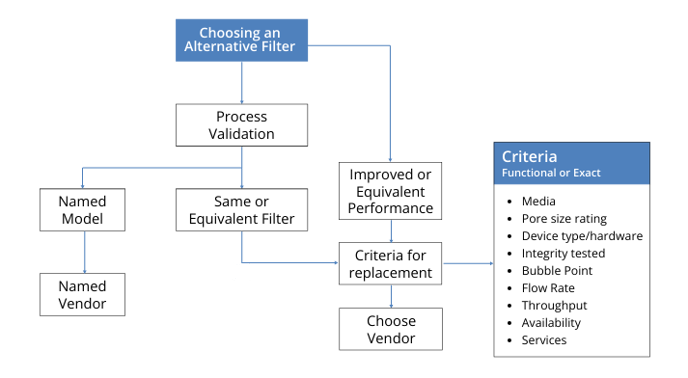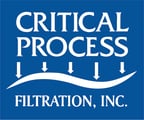A quality supplier should take the time to determine exactly what equivalent means to you and help you identify the appropriate filter(s).
How to evaluate a replacement filter equivalent to the one you're using now.
For any number of reasons, you’re looking for a new filter supplier. If your current filtration performance is satisfactory, replacing the filters with the correct equivalent will do. But if you need to improve filter performance, a different configuration of your current filter or a different type of filter will be the solution. Either way, a quality supplier should take the time to determine exactly what equivalent means to you and help you identify the appropriate filter(s).
First, let's start with the definition of “equivalent”.
Are you looking for a functional equivalent - where the new filter just has to work the same with some leeway for different filter media and materials of construction, or do you need an exact equivalent - same filter media, support material, hardware material, etc., as well as the same performance characteristics?
In many cases, this will depend on the application. For a water system or other non-critical stream, as long as it can be demonstrated to work properly there is probably a great deal of latitude in filter choice. For a more critical stream or validated process, there will be less room (if any) for deviation from the type of filter already in use. This may require the same filter media, the same materials of construction, the same level of testing and documentation, regulatory compliance data, validation, etc. It's not uncommon for users requesting an exact filter to simply refer to the media and hardware materials. Nonetheless, we review the criteria list carefully when recommending any type of equivalent filter.

How to Identify a Functionally Equivalent Filter
The first step is to identify the required material and performance characteristics.
- What are you filtering?
- The chemical/biological makeup of the stream being filtered will help identify any potential filter compatibility issues which may limit the choices for alternatives.
- Pore size & removal requirements?
- What size particles are being removed?
- Do you require an absolute rated filter, or will a nominal rated filter suffice?
- What is the particle load in your stream? Are there any premature fouling issues with your current filter?
- Flow rate and Batch size?
- What flow rate is required for your process?
- What is the target batch size to be processed with a set of filters?
- Is there any validation or regulatory compliance requirements?
- Bacteria retention
- FDA/EU food contact
- Toxicity compliance
- TOC & Conductivity
- Endotoxins and other Extractables
- Non-Fiber Releasing
- What filter configuration is required?
- Cartridge, capsule, or mini-capsule
- End fittings required for a specific filter housing
- How are your system and filters sanitized?
- Hot Water
- Steam
- Autoclave
- Chemical
Once you have identified the basic filter requirements, there are two paths forward.
You can spend a lot of time searching websites or you can call the vendor and ask for their recommendations based on the criteria we just discussed.
At Critical Process Filtration, we aim to make this process simple and productive for you. By visiting our Product Overview, you'll be able to determine quickly which product path to go down. This will provide data sheets for each type of product and sufficient information to help identify and size an appropriate replacement filter.
-
- For absolute-rated liquid filtration, the best choice is usually a Polyethersulfone (PES) membrane. This can be combined with an integral prefilter for extended life. For solvents or other liquids that are not compatible with PES, Nylon 6,6 is the best alternative. For extremely aggressive liquids a PTFE membrane may be required.
- For gas filtration or venting applications, a hydrophobic PTFE membrane filter is the best choice.
- For nominal-rated liquid filtration, the choices are Polypropylene or Fiberglass depth filters. Polypropylene has the best retention, while fiberglass has better flow and throughput. For high solids loading, a high loft polypropylene depth filter offers the best dirt holding capacity with better retention, but the tradeoff would be lower initial flow rates
When questions arise (and they will), arrange a conference call with the Critical Process Filtration Applications Engineering team to discuss your filtration requirements and identify your best alternative(s). To set up a conference call or email the sales team at sales@criticalprocess.com or call (603) 880-4420.
During this discussion, the CPF team will evaluate your requirements to see if there is enough information to make a definite recommendation or if additional testing may be required to provide data to identify the best solution and properly size filters for your process. This testing will ideally be performed using your fluid and may include:
-
- Filterability testing to identify the initial flow rate and how fast your fluid will clog a candidate filter.
- Prefilter or sequential filtration is required to meet your batch size.
- Testing the filtrate to ensure it meets your filtration objectives.
This testing can be performed either in the CPF Applications lab or at your site as required.
Once the testing is complete, a report will be generated showing the recommended filter(s), along with a performance summary and sizing requirements.
After reviewing the report at a follow-up conference call, final testing and verification/validation of performance are conducted in your process. If needed the CPF Applications team can assist in developing verification/validation protocols, execution, and documentation leading to implementation.
An Example of a Functional Filter Equivalent used in Bioprocessing
A US-based cancer institute filters cell culture media. They have been a long-time user of another brand's filter but ran into delivery issues.
.png?%20Capsule%20Filters%20(2).png&?%20Capsule%20Filters%20(2).png&width=521&name=High%20FLOW%20Sterilizing%20Cartridge%20%26%20Capsule%20Filters%20(2).png?%20Capsule%20Filters%20(2).png&?%20Capsule%20Filters%20(2).png)
How to Identify an Exact Equivalent Filter
In some ways, this is a more straightforward process than identifying a functional equivalent, as the choices are limited. This can also make it somewhat difficult, as there is little (if any) room for changes from the filter you are currently using.

The first step is to review the data sheet from your current supplier and identify critical materials of construction and performance characteristics. This can then be compared side-by-side with the Critical Process Filtration data sheet for a filter using the same membrane/media material
If you prefer, a CPF Application engineer will review your current data sheet and cross match to our equivalent (or as close as possible). A data package is then prepared to compare each material and critical performance characteristic to ensure equivalence. If there are any differences (material or performance) they are reviewed with the customer to determine acceptability. The only way to get any closer to the existing filter is to purchase the same model from the same vendor.
If an acceptable equivalent is identified, CPF will work with you to identify and conduct any testing and verification/validation activities required prior to implementation.
The Bottom Line.
At the end of the day, it's all about reaching your filtration goals while adhering to your business requirements. CPF partners with you to do just that.
Are you in search of an alternative filter?
Send us your specifications, and we'll recommend a suitable CPF replacement.
Critical Process Filtration manufactures high-quality process filters used in critical applications in several industries. Made in the USA, our products are produced under an ISO 9001-certified quality management system and we offer some of the best lead times in the industry.

